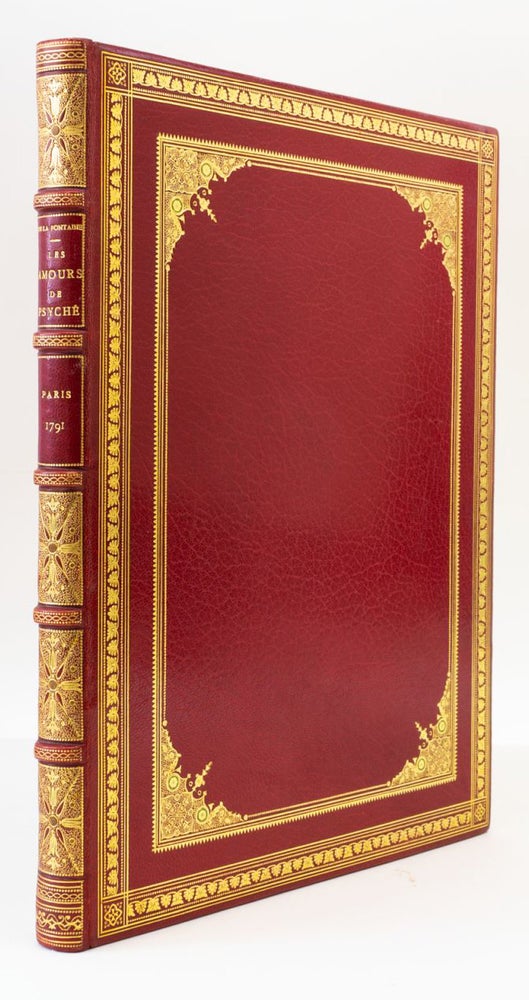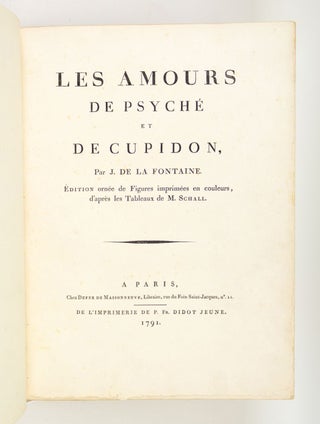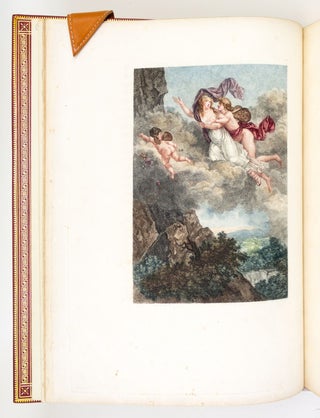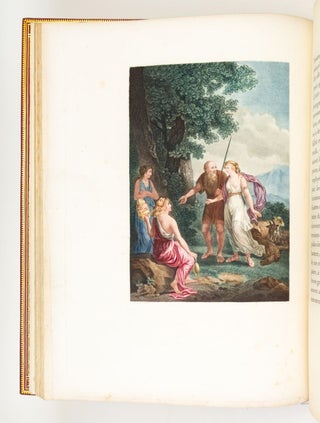LES AMOURS DE PSYCHÉ ET DE CUPIDON.
(Paris: [Printed by] P. Fr. Didot jeune [for] Chez Defer de Maisonneuve, 1791). 352 x 263 mm. (14 x 10 1/2"). 163 pp., [2] leaves (the often-missing prospectus leaf for "Paradise Lost," to be published in a uniform edition in 1792, and the final blank). First Edition with these Illustrations.
FINE SCARLET MOROCCO, GILT AND INLAID IN THE STYLE OF BOZERIAN BY CHARLES DE SAMBLANX (stamp-signed on front turn-in), covers with outer frame of double fillets and palmette roll, cruciform tool at corners, central panel framed by dogtooth roll and gilt fillets, intricate pointillé cornerpieces with two small inlaid medallions of green morocco tooled with gilt daisies, lancet tool extending toward center, raised bands, spine compartments with fleuron centerpiece of floral and lancet tools emanating from an inlaid central citron morocco dot, on a densely pointillé ground, gilt titling, turn-ins with gilt fillets and Greek key roll, marbled endpapers, top edge gilt. In the original marbled paper slipcase (matching the endpapers). WITH FOUR STIPPLE-ENGRAVED COLOR PLATES after M. Schall. A LARGE PAPER COPY, PRINTED ON PAPIER VÉLIN. Cohen-de Ricci 582; Fürstenberg 124; Lewine, p. 283; Maggs 1930 Catalogue of French Illustrated Books, #135. ◆Trivial rubbing to tail of rear joint and tail edge of spine, occasional mild marginal foxing or faint browning, isolated rust spots, one leaf with small smudge to fore-edge margin, but A FINE COPY, clean and fresh internally with vast margins, the plates with rich coloring, and IN A SPARKLING BINDING.
This is an especially tall copy of a handsomely color-illustrated version of the myth of Cupid and Psyche, in period-style morocco by Belgian master binder Charles de Samblanx. It is one of the grander French books to be printed in color when the vogue for such productions took hold during the last years of the 18th century. The plates give a feeling of lushness and even sensuality, and the colors here (with reds and purples always noticeable) add a resonance to these sensations not obtainable with a black & white engraving. Cohen-de Ricci does not mention the existence of large paper copies or special paper, but the amplitude of the margins here and the special, thick papier vélin seem to justify making such claims for the present copy.
La Fontaine (1621-95) is best known for his "Fables," considered one of the masterpieces of French literature, but his retelling of Apuleius' classic story of the obstacles faced by the god of love and his mortal wife is lauded by Britannica for "the lucid elegance of its prose, its skillful blend of delicate feeling and witty banter, and some sly studies of feminine psychology." These same descriptors could apply to the illustrations here by painter Jean Frédéric Schall (1752-1825), which are very much in the tradition of Watteau and Fragonard. Pretty and sentimental but with erotic undercurrents, these depictions of key moments in the tale are much enhanced by the fine color printing, duplicating with exactness the soft, romantic shades of the Rococo masters.
Charles de Samblanx [or Samblancx] (1855-1943) began working in the binding trade at age 11 as an apprentice to Coppens. He eventually established his own firm, which was known from 1889-1909 as Samblancx-Weckesser, since de Samblanx had taken his gilder Jacques Weckesser into partnership. After 1909, de Samblanx again headed the firm alone. His binding career extended over several decades, and he worked in a variety of period styles, sensitively reproducing the bindings of previous centuries. Many of his bindings are now in the Royal Museum of Mariemont in Belgium. They are unfailingly exemplary in terms of design and execution. (ST16967)
Price: $6,500.00




